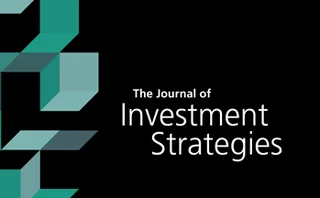Technical paper/Tail risk
The WWR in the tail: a Monte Carlo framework for CCR stress testing
A methodology to compute stressed exposures based on a Gaussian copula and mixture distributions is introduced
Fat tails and optimal LDI portfolios
A portfolio optimisation technique for pension funds and insurance portfolios is presented
Measuring tail operational risk in univariate and multivariate models with extreme losses
The authors consider operational risk models and derive limit behaviors for the value-at-risk and conditional tail expectation of aggregate operational risks in such models.
Modeling maxima with a regime-switching Fréchet model
The authors identify a regime-switching Fréchet model which can be used to identify the behavior of extreme values in financial series.
Assessing systemic fragility: a probabilistic perspective
Using new measure of systemic fragility, the author ranks euro area banks and sovereigns and according to their systemic risk contribution.
An examination of the tail contribution to distortion risk measures
This paper reports a method for analyzing the influence of the tail in calculations of distortion risk measures.
Procyclicality control in risk-based margin models
This paper revisits the procyclicality issue in risk-based margin models and provides additional insight on procyclicality mitigation techniques.
Body and tail: an automated tail-detecting procedure
The quality of a tail model, which is determined by data from an unknown distribution, depends critically on the subset of data used to model the tail. Based on a suitably weighted mean square error, the authors present a completely automated method that…
Fund size and the stability of portfolio risk
This paper examines the relationship between portfolio size and the stability of mutual fund risk measures, presenting evidence for economies of scale in risk management.
Procyclicality mitigation for initial margin models with asymmetric volatility
In this paper, we explore the procyclicality of initial margin requirements based on VaR volatility models.We suggest procyclicality can be reduced using a three-regime model rather than using ad hoc tools.
Validation of index and benchmark assignment: adequacy of capturing tail risk
This paper provides practical recommendations for the validation of risk models under the Targeted Review of Internal Models (TRIM).
Measuring expected shortfall under semi-parametric expected shortfall approaches: a case study of selected Southern European/Mediterranean countries
In this paper, the authors investigate the applicability of semi-parametric approaches for estimating expected shortfall.
Tail-risk mitigation with managed volatility strategies
This paper examines strategy performance from an investment practitioner perspective. Using long-term data from the Standard & Poor’s 500, the authors show that these strategies offer an improvement in risk-adjusted return compared with a buy-and-hold…
Keep it real: tail probabilities of compound distributions
Igor Halperin proposes new approach to compute probabilities of heavy-tailed distributions
New backtests for unconditional coverage of expected shortfall
In this paper, the authors present a new backtest for the unconditional coverage property of expected shortfall.
Rogue traders versus value-at-risk and expected shortfall
VAR and ES are ineffective to deter rogue trading
The application of Hermite polynomials to risk allocation
This paper investigates a practical and fast analytic framework for portfolio modeling and tail risk allocation using Hermite polynomials.
Tail risk premiums versus pure alpha
Tail-risk skewness, rather than volatility, is correlated with risk premiums
Cutting Edge introduction: Followers of fashion
Focusing on how often a trading strategy ends on the winning side can distract from the question of whether it profits on average. The key is in the return distribution’s skew – and at least for trend-following strategies this can be directly controlled…
A rotationally invariant technique for rare event simulation
Because of their low probability, including extreme events in Monte Carlo calculations of the value-at-risk of a credit-risky portfolio requires many simulations. Here, Susanne Klöppel, Ranja Reda and Walter Schachermayer demonstrate a geometrically…










